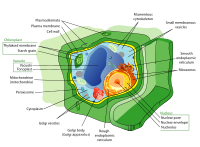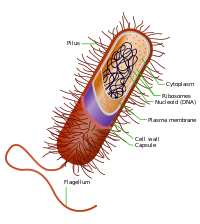Selula
   | |
| Tipikal na istraktura nin selula kan mga (1) Tinanom (2) Hayop (3) Prokaryotikong organismo |
An selula (Ingles: cell; gikan sa Latin na cella, boot-sabihon "sadit na kwarto"[1]) iyo an pangenot na istraktural, minagana, asin biyolohikal na yunit nin gabos na aram na mga organismo. An sarong selula iyo an pinakasadit na yunit nin buhay. An mga selula iyo harus inaapod na "panghaman na bloke kan buhay". An pag-aadal nin mga selula iyo inaapod na selulang biyolohiya, selular na biyolohiya, o sitolohiya.
An mga selula iyo pigbibilog nin mga cytoplasm na nakakaag sa laog sa sarong membrana, na igwang nagkapirang mga biyomolekula arug kan mga protina asin nukleyikong asido.[2] Harus nin mga selula kan tinanom sagkod hayop iyo nahihiling sana sa irarom nin "light microscope", na may dimensyon sa tahaw nin 1 asin 100 mikrometro.[3] An elektron na mikroskopiya iyo minatao nin mas halangkaw na resolusyon na nagpapahiling nin mas detalyadong istraktura nin mga selula. An mga organismo pupuwedeng maklasipika bilang uniselular (pigbibilog nin sarong solong selula arug kan bakterya) o multiselular (kabale an mga tinanom sagkod hayop). Kadaklan nin mga uniselular na organismo iyo nakaklaplisika bilang mikroorganismo.
An numero nin selula sa mga tinanom sagkod hayop iyo mangiba-iba sa manlainlain na mga espesye. Sa mga tawo, naestima na igwang harus na 40 trilyon (4×1013) na mga selula.[lower-alpha 1][4] An utak pa sana nin tawo iyo igwa na nin harus 80 bilyon kan mga selulang ini.[5]
An mga selula iyo nadiskobre ni Robert Hooke kaidtong 1665, na pigtawan an mga ini nin pangaran base sa similaridad kan mga ini sa mga selula na pig-iistaran nin mga Kristiyanong mga monghe sa sarong monasteryo.[6][7] An Teoryang Selula, na enot nahaman kaidtong 1839 ni Matthias Jakob Schleiden asin Theodor Schwann, nagsasabi na an gabos na organismo iyo nabibilog nin saro o mas dakul na mga selula, kun sain an mga selula iyo an pundamental na yunit nin istraktura asin paggana sa gabos na mga nabubuhay na organismo, asin an gabos na mga selula iyo gikan sa mga nagligad na nabuhay na mga selula.[8] An mga selula iyo naglataw sa Kinaban dae mababa sa 3.5 bilyon na taon na an nakalihis.
Hilingon man
[baguhon | baguhon an source]Toltolan
[baguhon | baguhon an source]- ↑ "Cell". Online Etymology Dictionary. Retrieved 31 December 2012.
- ↑ Cell Movements and the Shaping of the Vertebrate Body in Chapter 21 of Molecular Biology of the Cell fourth edition, edited by Bruce Alberts (2002) published by Garland Science.
The Alberts text discusses how the "cellular building blocks" move to shape developing embryos. It is also common to describe small molecules such as amino acids as "molecular building blocks". - ↑ Campbell, Neil A.; Williamson, Brad; Heyden, Robin J. (2006). Biology: Exploring Life. Boston, Massachusetts: Pearson Prentice Hall. ISBN 9780132508827.
- ↑ 4.0 4.1 4.2 "An estimation of the number of cells in the human body". Annals of Human Biology 40 (6): 463–71. November 2013. doi:. PMID 23829164. https://www.researchgate.net/publication/248399628. "These partial data correspond to a total number of 3.72±0.81×1013 [cells].".
- ↑ "Equal numbers of neuronal and nonneuronal cells make the human brain an isometrically scaled-up primate brain". The Journal of Comparative Neurology 513 (5): 532–41. April 2009. doi:. PMID 19226510.
- ↑ Karp, Gerald (19 October 2009). Cell and Molecular Biology: Concepts and Experiments. John Wiley & Sons. p. 2. ISBN 9780470483374.
Hooke called the pores cells because they reminded him of the cells inhabited by monks living in a monastery.
- ↑ Tero, Alan Chong (1990). Achiever's Biology. Allied Publishers. p. 36. ISBN 9788184243697.
In 1665, an Englishman, Robert Hooke observed a thin slice of" cork under a simple microscope. (A simple microscope is a microscope with only one biconvex lens, rather like a magnifying glass). He saw many small box like structures. These reminded him of small rooms called "cells" in which Christian monks lived and meditated.
- ↑ Maton, Anthea (1997). Cells Building Blocks of Life. New Jersey: Prentice Hall. ISBN 9780134234762.
Mga nota
[baguhon | baguhon an source]- ↑ An approximation made for someone who is 30 years old, weighs 70 kilograms (150 lb), and is 172 centimetres (5.64 ft) tall.[4] The approximation is not exact, this study estimated that the number of cells was 3.72±0.81×1013.[4]
| An Wikimedia Commons igwa nin medya dapit sa Cells. |
